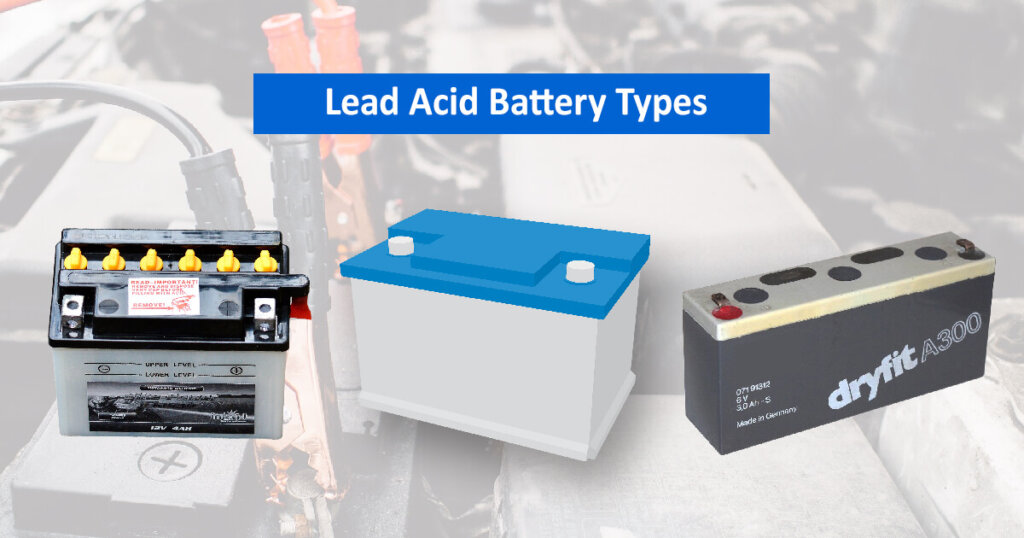We have seen Lithium Batteries that are replacements for Lead Acid batteries. But based on its applications it is not exactly compatible in all cases. Because Lithium batteries are sensitive to temperature. We cannot able to put a Lithium battery near our car engines as it would be hot during operation. This actually reduces the cycle life of lithium batteries.
This is one of the reasons why lead-acid batteries are still not replaced in old vehicles. From now on manufacturers may provide a safer place for lithium batteries (if opted) when popular and becomes affordable.
Likewise, lithium batteries, lead-acid batteries are also available in various types. The most common types of lead-acid batteries are
- Flooded Lead Acid Batteries
- AGM Batteries (Absorbent Glass Mat)
- Gel Batteries
Based on applications and operating environments these batteries are used in standard vehicles, sports vehicles, or home use.
Learn more about the Battery basics of Amp Hour, Watt Hour, etc.
Flooded Lead Acid Battery:
A Flooded Lead-acid battery is a most general-purpose battery that is used in most vehicles and home UPS. It is made up of lead plates and liquid electrolytic solution (Sulphuric Acid).
Pros:
- Flooded Lead Acid batteries are cheaper in cost.
- Slower charging time.
- Easy to service
- Good Current Delivery but degraded when not maintained properly.
Cons:
- It can be mounted straight and cannot be mounted sideways. The liquid may spill out in case of fell down.
- Sulphation formation is expected
- Self Discharge is high
In Standard Lead-acid batteries also there was some improvement to improve its service life, they are called Tubular Batteries, but it comes under lead acid battery type only, the only difference is the tubular battery has a replaceable positive plate made up of tube with a cloth. Below are examples of Liquid electrolyte-based Lead Acid Batteries.
AGM Batteries:
AGM Batteries are another type of technology used in Lead Acid Batteries. In this battery, the electrolyte is suspended in a fiberglass mat inside each cell to prevent spillage. AGM Batteries are extremely resistant to vibration, are totally sealed, non-spillable, and maintenance-free. So these batteries are priced a little higher but have a good life and good performance.
AGM Batteries are used in start-stop technology vehicles because, in start technology, the vehicle engine is turned off in the signal to save fuel and automatically quickly restart when the brake is removed. During this time, all the electronics in the car or bike depend on its battery requires good performance to start the engine frequently.
Pros:
- Great Mounting Flexibility.
- Used in start-stop vehicle technology, sports vehicle.
- Moderate service life
- Sulphation formation is expected but not worse than a Flooded Battery
- Less self discharge rate
- High Current delivery
Cons:
- Price is moderately higher than flooded lead acid battery
- Difficult to service as it is sealed. But it is mostly maintenance free.
Gel Batteries:
Gel batteries are another type of technology used in Lead-Acid batteries. In Gel Batteries, instead of electrolyte liquid, it is replaced by a liquid gel electrolyte. Hence it is spillproof and can be mounted both straight and sideways. The price of these batteries is higher than both Flooded and AGM Batteries.
Pros:
- Great Mounting Flexibility.
- Maintenance Free
- Faster charging time than flooded lead-acid.
- Good service life
- Rugged and Vibration-resistant
- Possibly no sulphation because of Gel Electrolyte
- Less self discharge rate
- High Current delivery
Cons:
- Difficult to service as it is sealed but it is mostly maintenance free.
- Cost is higher than Flooded Lead Acid and AGM Batteries
Conclusion:
As we saw, even in lead-acid batteries we had multiple models based on its applications (even more available). As lithium batteries are in the early stage, many companies can make different features to overcome their limitations. So whenever you choose a battery, you need to decide does it work for our applications and withstand the operational environment.











